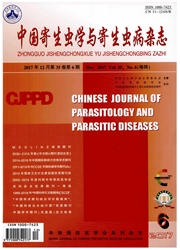

 中文摘要:
中文摘要:
目的对云南三大高原湖泊广州管圆线虫动物宿主进行初步调查,分析历年温度对广州管圆线虫的影响。方法2012年4月至9月在云南省大理洱海、玉溪抚仙湖和星云湖3大高原湖泊开展广州管圆线虫流行病学调查。用胃蛋白酶消化法或肺检法剖检采集的螺类,调查广州管圆线虫Ⅲ期幼虫感染情况。捕捉到的啮齿类动物鉴别种类后,检查感染情况。对采集到的气象等相关数据进行整理、分析和利用有效积温等原理构建GIS预测模型。结果云南3大湖泊共采集4种螺4950只,分别为福寿螺(Pomacea canaliculata)、中国圆田螺(Cipangopaludina chinensis)、铜锈环棱螺(Bellamya aeruginosa)和方形环棱螺(B.quadrata),共捕获5种鼠类174只,螺和鼠均未检出广州管圆线虫幼虫或成虫。地理信息系统(GIS)构建的预测分布图显示,随着气温的增高,将导致福寿螺和广州管圆线虫在云南省发育历代数的范围逐年扩大,早期不能发育一代的区域,随着时间的推移能够完成一代的发育。结论本次调查未检出广州管圆线虫,但3大高原湖的自然环境、生态系统已具备广州管圆线虫自然传播的条件。
 英文摘要:
英文摘要:
Objective To investigated the intermediate hosts of Angiostrongylus cantonensis in three plateau lakes of Yunnan Province, and analyze the effect of temperature on A. cantonensis during 1991-2010. Methods An epidemio- logical investigation of angiostrongyliasis cantonensis in Erhai Lake, Fuxian Lake and Xingyun Lake was conducted from April to September in 2012. Snails were examined for the third stage larvae by enzyme digestion or lung examination. Ro- dents were captured in the fields, and their hearts and lungs were dissected for adult worms. The potential distribution of A. cantonensis and its main intermediate host Pomacea canaliculata were predicted based on degree-day models using GIS technique. Results A total of 4 950 snails were collected, belonging to 4 species, P. canaliculata, Cipangopaludina chi- nensis, BeUamya aeruginosa, and B. quadrata. 174 rodents were captured, belonging to 5 species. No positive samples were found. The potential distribution map showed that the distribution of A. cantonensis and E canaliculata in Yunnan would expand with the rise of temperature, and with the passage of time they could complete one generation in the region which couldn't finish one generation in one year along with time passing. Conclusion A. cantonensis are not found in the hosts. The natural environment and ecological system of the three lakes match the condition of A. cantonensis transmission.
 同期刊论文项目
同期刊论文项目
 同项目期刊论文
同项目期刊论文
 期刊信息
期刊信息
